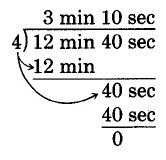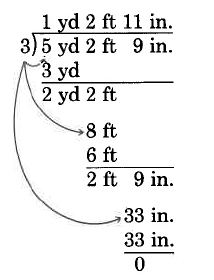6.1.5: Simplification of Denominate Numbers
\newcommand{\vecs}[1]{\overset { \scriptstyle \rightharpoonup} {\mathbf{#1}} }
\newcommand{\vecd}[1]{\overset{-\!-\!\rightharpoonup}{\vphantom{a}\smash {#1}}}
\newcommand{\id}{\mathrm{id}} \newcommand{\Span}{\mathrm{span}}
( \newcommand{\kernel}{\mathrm{null}\,}\) \newcommand{\range}{\mathrm{range}\,}
\newcommand{\RealPart}{\mathrm{Re}} \newcommand{\ImaginaryPart}{\mathrm{Im}}
\newcommand{\Argument}{\mathrm{Arg}} \newcommand{\norm}[1]{\| #1 \|}
\newcommand{\inner}[2]{\langle #1, #2 \rangle}
\newcommand{\Span}{\mathrm{span}}
\newcommand{\id}{\mathrm{id}}
\newcommand{\Span}{\mathrm{span}}
\newcommand{\kernel}{\mathrm{null}\,}
\newcommand{\range}{\mathrm{range}\,}
\newcommand{\RealPart}{\mathrm{Re}}
\newcommand{\ImaginaryPart}{\mathrm{Im}}
\newcommand{\Argument}{\mathrm{Arg}}
\newcommand{\norm}[1]{\| #1 \|}
\newcommand{\inner}[2]{\langle #1, #2 \rangle}
\newcommand{\Span}{\mathrm{span}} \newcommand{\AA}{\unicode[.8,0]{x212B}}
\newcommand{\vectorA}[1]{\vec{#1}} % arrow
\newcommand{\vectorAt}[1]{\vec{\text{#1}}} % arrow
\newcommand{\vectorB}[1]{\overset { \scriptstyle \rightharpoonup} {\mathbf{#1}} }
\newcommand{\vectorC}[1]{\textbf{#1}}
\newcommand{\vectorD}[1]{\overrightarrow{#1}}
\newcommand{\vectorDt}[1]{\overrightarrow{\text{#1}}}
\newcommand{\vectE}[1]{\overset{-\!-\!\rightharpoonup}{\vphantom{a}\smash{\mathbf {#1}}}}
\newcommand{\vecs}[1]{\overset { \scriptstyle \rightharpoonup} {\mathbf{#1}} }
\newcommand{\vecd}[1]{\overset{-\!-\!\rightharpoonup}{\vphantom{a}\smash {#1}}}
\newcommand{\avec}{\mathbf a} \newcommand{\bvec}{\mathbf b} \newcommand{\cvec}{\mathbf c} \newcommand{\dvec}{\mathbf d} \newcommand{\dtil}{\widetilde{\mathbf d}} \newcommand{\evec}{\mathbf e} \newcommand{\fvec}{\mathbf f} \newcommand{\nvec}{\mathbf n} \newcommand{\pvec}{\mathbf p} \newcommand{\qvec}{\mathbf q} \newcommand{\svec}{\mathbf s} \newcommand{\tvec}{\mathbf t} \newcommand{\uvec}{\mathbf u} \newcommand{\vvec}{\mathbf v} \newcommand{\wvec}{\mathbf w} \newcommand{\xvec}{\mathbf x} \newcommand{\yvec}{\mathbf y} \newcommand{\zvec}{\mathbf z} \newcommand{\rvec}{\mathbf r} \newcommand{\mvec}{\mathbf m} \newcommand{\zerovec}{\mathbf 0} \newcommand{\onevec}{\mathbf 1} \newcommand{\real}{\mathbb R} \newcommand{\twovec}[2]{\left[\begin{array}{r}#1 \\ #2 \end{array}\right]} \newcommand{\ctwovec}[2]{\left[\begin{array}{c}#1 \\ #2 \end{array}\right]} \newcommand{\threevec}[3]{\left[\begin{array}{r}#1 \\ #2 \\ #3 \end{array}\right]} \newcommand{\cthreevec}[3]{\left[\begin{array}{c}#1 \\ #2 \\ #3 \end{array}\right]} \newcommand{\fourvec}[4]{\left[\begin{array}{r}#1 \\ #2 \\ #3 \\ #4 \end{array}\right]} \newcommand{\cfourvec}[4]{\left[\begin{array}{c}#1 \\ #2 \\ #3 \\ #4 \end{array}\right]} \newcommand{\fivevec}[5]{\left[\begin{array}{r}#1 \\ #2 \\ #3 \\ #4 \\ #5 \\ \end{array}\right]} \newcommand{\cfivevec}[5]{\left[\begin{array}{c}#1 \\ #2 \\ #3 \\ #4 \\ #5 \\ \end{array}\right]} \newcommand{\mattwo}[4]{\left[\begin{array}{rr}#1 \amp #2 \\ #3 \amp #4 \\ \end{array}\right]} \newcommand{\laspan}[1]{\text{Span}\{#1\}} \newcommand{\bcal}{\cal B} \newcommand{\ccal}{\cal C} \newcommand{\scal}{\cal S} \newcommand{\wcal}{\cal W} \newcommand{\ecal}{\cal E} \newcommand{\coords}[2]{\left\{#1\right\}_{#2}} \newcommand{\gray}[1]{\color{gray}{#1}} \newcommand{\lgray}[1]{\color{lightgray}{#1}} \newcommand{\rank}{\operatorname{rank}} \newcommand{\row}{\text{Row}} \newcommand{\col}{\text{Col}} \renewcommand{\row}{\text{Row}} \newcommand{\nul}{\text{Nul}} \newcommand{\var}{\text{Var}} \newcommand{\corr}{\text{corr}} \newcommand{\len}[1]{\left|#1\right|} \newcommand{\bbar}{\overline{\bvec}} \newcommand{\bhat}{\widehat{\bvec}} \newcommand{\bperp}{\bvec^\perp} \newcommand{\xhat}{\widehat{\xvec}} \newcommand{\vhat}{\widehat{\vvec}} \newcommand{\uhat}{\widehat{\uvec}} \newcommand{\what}{\widehat{\wvec}} \newcommand{\Sighat}{\widehat{\Sigma}} \newcommand{\lt}{<} \newcommand{\gt}{>} \newcommand{\amp}{&} \definecolor{fillinmathshade}{gray}{0.9}6.1.5 Learning Objectives
- Convert an unsimplified unit of measure to a simplified unit of measure
- Perform arithmetic calculations with denominate numbers
Converting to Multiple Units
Definition: Denominate Numbers
Numbers that have units of measure associated with them are called denominate numbers. It is often convenient, or even necessary, to simplify a denominate number.
Definition: Simplified Denominate Numbers
A denominate number is simplified when the number of standard units of measure associated with it does not exceed the next higher type of unit.
The denominate number 55 min is simplified since it is smaller than the next higher type of unit, 1 hr. The denominate number 65 min is not simplified since it is not smaller than the next higher type of unit, 1 hr. The denominate number 65 min can be simplified to 1 hr 5 min. The denominate number 1 hr 5 min is simplified since the next higher type of unit is day, and 1 hr does not exceed 1 day.
Example 1
Simplify 19 in.
Solution
Since \text{12 in = 1 ft.}, and 19 = 12 + 7,
\begin{array} {rcl} {\text{19 in}} & = & {\text{12 in + 7 in}} \\ {} & = & {\text{1 ft + 7 in}} \\ {} & = & {\text{1 ft 7 in}} \end{array}
Example 2
Simplify 4 gal 5 qt.
Solution
Since \text{4 qt = 1 gal}, and 5 = 4 + 1,
\begin{array} {rcl} {\text{4 gal 5 qt}} & = & {\text{4 gal + 4 qt + 1 qt}} \\ {} & = & {\text{4 gal + 1 gal + 1 qt}} \\ {} & = & {\text{5 gal + 1 qt}} \\ {} & = & {\text{5 gal 1 qt}}\end{array}
Example 3
Simplify 2 hr 75 min.
Solution
Since \text{60 min = 1 hr}, and 75 = 60 + 15,
\begin{array} {rcl} {\text{2 hr 75 min}} & = & {\text{2 hr + 60 min + 15 min}} \\ {} & = & {\text{2 hr + 1 hr + 15 min}} \\ {} & = & {\text{3 hr + 15 min}} \\ {} & = & {\text{3 hr 15 min}}\end{array}
Example 4
Simplify 43 fl oz.
Solution
Since \text{8 fl oz = 1 c} (1 cup), and 43 \div 8 = \text{5R3},
\begin{array} {rcl} {\text{43 fl oz}} & = & {\text{40 fl oz + 3 fl oz}} \\ {} & = & {5 \cdot 8 \text{ fl oz + 3 fl oz}} \\ {} & = & {5 \cdot 1 \text{ c + 3 fl oz}} \\ {} & = & {\text{5 c + 3 fl oz}}\end{array}
But, \text{2c = 1 pt} and 5 \div 2 = \text{2R1}. So,
\begin{array} {rcl} {\text{5 c + 3 fl oz}} & = & {2 \cdot 2 \text{ c + 1 c + 3 fl oz}} \\ {} & = & {2 \cdot 1 \text{ pt + 1 c + 3 fl oz}} \\ {} & = & {\text{2 pt + 1 c + 3 fl oz}} \end{array}
But, \text{2 pt = 1 qt}, so
\text{2 pt + 1 c + 3 fl oz = 1 qt 1 c 3 fl oz}
Try It Now 1
Simplify each denominate number. Refer to the conversion tables given in [link], if necessary.
- 18 in
- 8 gal 9 qt
- 5 hr 80 min
- 8 wk 11 days
- 86 days
- Answer
-
- 1 ft 6 in
- 10 gal 1 qt
- 6 hr 20 min
- 9 wk 4 days
- 12 wk 2 days
Adding and Subtracting Denominate Numbers
Adding and Subtracting Denominate Numbers
Denominate numbers can be added or subtracted by:
- writing the numbers vertically so that the like units appear in the same column.
- adding or subtracting the number parts, carrying along the unit.
- simplifying the sum or difference.
Example 5
Add 6 ft 8 in to 2 ft 9 in.
Solution
\begin{array} {r} {\text{6 ft 8 in}} \\ {\underline{\text{+ 2 ft 9 in}}} \\ {\text{8 ft 17 in}} \end{array} Simplify this denominate number.
Since \text{12 in = 1 ft},
\begin{array} {rcl} {\text{8 ft + 12 in + 5 in}} & = & {\text{8 ft + 1 ft + 5 in}} \\ {} & = & {\text{9 ft + 5 in}} \\ {} & = & {\text{9 ft 5 in}} \end{array}
Example 6
Subtract 5 da 3 hr from 8 da 11 hr.
Solution
\begin{array} {r} {\text{8 da 11 hr}} \\ {\underline{\text{- 5 da 3 hr}}} \\ {\text{3 da 8 hr}} \end{array}
Example 7
Subtract 3 lb 14 oz from 5 lb 3 oz.
Solution
\begin{array} {r} {\text{5 lb 3 oz}} \\ {\underline{\text{- 3 lb 14 oz}}} \end{array}
We cannot directly subtract 14 oz from 3 oz, so we must borrow 16 oz from the pounds.
\begin{array} {rcl} {\text{5 lb 3 oz}} & = & {\text{5 lb + 3 oz}} \\ {} & = & {\text{4 lb + 1 lb + 3 oz}} \\ {} & = & {\text{4 lb + 16 oz + 3 oz (Since 1 lb = 16 oz)}} \\ {} & = & {\text{4 lb + 19 oz}} \\ {} & = & {\text{4 lb 19 oz}} \end{array}
\begin{array} {r} {\text{4 lb 19 oz}} \\ {\underline{\text{- 3 lb 14 oz}}} \\ {\text{1 lb 5 oz}} \end{array}
Example 8
Subtract 4 da 9 hr 21 min from 7 da 10 min.
Solution
\begin{array} {r} {\text{7 da 0 hr 10 min}} \\ {\underline{\text{- 4 da 9 hr 21 min}}} \end{array} Borrow 1 da from the 7 da.
\begin{array} {r} {\text{6 da 24 hr 10 min}} \\ {\underline{\text{- 4 da 9 hr 21 min}}} \end{array} Borrow 1 hr from the 24 hr.
\begin{array} {r} {\text{6 da 23 hr 70 min}} \\ {\underline{\text{- 4 da 9 hr 21 min}}} \\ {\text{2 da 14 hr 49 min}} \end{array}
Try It Now 2
Perform each operation. Simplify when possible.
- Add 4 gal 3 qt to 1 gal 2 qt.
- Add 9 hr 48 min to 4 hr 26 min.
- Subtract 2 ft 5 in from 8 ft 7 in.
- Subtract 15 km 460 m from 27 km 800 m.
- Subtract 8 min 35 sec from 12 min 10 sec.
- Answer
-
- 6 gal 1 qt
- 14 hr 14 min
- 6 ft 2in
- 12 km 340 m
- 3 min 35 sec
Multiplying a Denominate Number by a Whole Number
Let's examine the repeated sum
\underbrace{\text{4 ft 9 in + 4 ft 9 in + 4 ft 9 in}}_{\text{3 times}} = \text{12 ft 27 in}
Recalling that multiplication is a description of repeated addition, by the distributive property we have
\begin{array} {rcl} {\text{3(4 ft 9 in)}} & = & {\text{3 (4ft + 9 in)}} \\ {} & = & {3 \cdot 4 \text{ ft } + 3 \cdot 9 \text{ in}} \\ {} & = & {\text{12 ft + 27 in. Now, 27 in = 2 ft 3 in}} \\ {} & = & {\text{12 ft + 2 ft + 3 in}} \\ {} & = & {\text{14 ft + 3 in}} \\ {} & = & {\text{14 ft 3 in}} \end{array}
From these observations, we can suggest the following rule.
Multiplying a Denominate Number by a Whole Number
To multiply a denominate number by a whole number, multiply the number part of each unit by the whole number and affix the unit to this product.
Example 9
Perform the following multiplications. Simplify if necessary.
\begin{array} {rcl} {6 \cdot \text{(2 ft 4 in)}} & = & {6 \cdot 2 \text{ ft + 6} \cdot 4 \text{in}} \\ {} & = & {\text{12 ft + 24 in}} \end{array}
Since \text{3 ft = 1 yd} and \text{12 in = 1 ft},
\begin{array} {rcl} {\text{12 ft + 24 in}} & = & {\text{4 yd + 2 ft}} \\ {} & = & {\text{4 yd 2 ft}} \end{array}
Example 10
\begin{array} {rcl} {8 \cdot \text{(5 hr 21 min 55 sec)}} & = & {8 \cdot 5 \text{ hr} + 8 \cdot 21 \text{ min} + 8 \cdot 55 \text{ sec}} \\ {} & = & {\text{40 hr + 168 min + 440 sec}} \\ {} & = & {\text{40 hr + 168 min + 7 min + 20 sec}} \\ {} & = & {\text{40 hr + 175 min + 20 sec}} \\ {} & = & {\text{40 hr + 2 hr + 55 min + 20 sec}} \\ {} & = & {\text{42 hr + 55 min + 20 sec}} \\ {} & = & {\text{24 hr + 18 hr + 55 min + 20 sec}} \\ {} & = & {\text{1 da + 18 hr + 55 min + 20 sec}} \\ {} & = & {\text{1 da 18 hr 55 min 20 sec}} \end{array}
Try It Now 3
Perform the following multiplications. Simplify.
- 2 \cdot \text{(10 min)}
- 5 \cdot \text{(3 qt)}
- 4 \cdot \text{(5 ft 8 in)}
- Answer
-
- 20 min
- \text{15 qt = 3 gal 3 qt}
- \text{20 ft 32 in = 7 yd 1 ft 8 in}
Dividing a Denominate Number by a Whole Number
Dividing a Denominate Number by a Whole Number
To divide a denominate number by a whole number, divide the number part of each unit by the whole number beginning with the largest unit. Affix the unit to this quotient. Carry any remainder to the next unit.
Example 11
Perform the following divisions. Simplify if necessary.
\text{(12 min 40 sec)} \div 4
Solution

Thus \text{(12 min 40 sec)} \div 4 = \text{3 min 10 sec}.
Example 12
\text{(5 yd 2 ft 9 in)} \div 3
Solution

\begin{array} {c} {\text{Convert to feet: 2 yd 2 ft = 8 ft}} \\ {\text{Convert to inches: 2 ft 9 in. = 33 in}} \end{array}
Thus \text{(5 yd 2 ft 9 in)} \div 3 = \text{1 yd 2 ft 11 in}.
Try It Now 4
Perform the following divisions. Simplify if necessary.
- \text{(18 hr 36 min)} \div 9
- \text{(36 hr 8 min)} \div 8
- \text{(13 yd 7 in)} \div 5
- Answer
-
- 2 hr 4 min
- 4 hr 18 min
- 2 yd 1 ft 11 in


